Know about Salmon Faverolle chicken origin & history, appearance, eggs, characteristics, hen vs rooster, week by week chicks, price, owner suitability, pros & cons, and many more in detail.
Overview
Salmon Faverolle chickens are a delightful and distinctive breed, beloved for their friendly personalities and unique looks. If you’re an experienced poultry keeper or just starting your backyard flock, learning about the history, traits, and care needs of Salmon Faverolle chickens will help you determine if they’re the right fit for your coop.
Salmon Faverolle Chicken Origin & History
Salmon Faverolle chickens hail from France, specifically the village of Faverolles in the northern region. Developed in the late 19th century, these chickens were initially bred for meat production but have since become popular for their egg-laying capabilities and friendly nature. Contributors to the breed’s development include Houdans, Dorkings, and Asian breeds like the Brahma and Cochin.
Salmon Faverolle Chicken Appearance
Salmon Faverolle chickens are easily recognizable with their fluffy beards and muffs, feathered legs, and five toes on each foot—a trait uncommon among most chicken breeds. They exhibit a beautiful salmon-colored plumage, which contrasts with their white and black feathers. Typically, hens weigh around 6.5 pounds, while roosters can reach up to 8 pounds. They have a single comb, red wattles, and white earlobes, adding to their distinctive look.
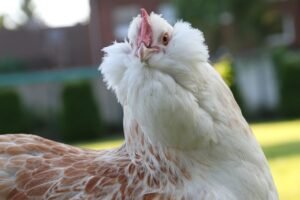
Salmon Faverolle Chicken Eggs
Salmon Faverolle chicken Egg Colors
Salmon Faverolle chickens lay medium to large-sized eggs that are tinted a lovely creamy or light brown color.
If you are fond of colorful eggs, know about 7 blue egg-laying hens.
Salmon Faverolle chicken Egg Production
These chickens are reliable layers, producing about 4-5 eggs per week. This translates to approximately 200-240 eggs per year, making them a good choice for those seeking a steady supply of fresh eggs.
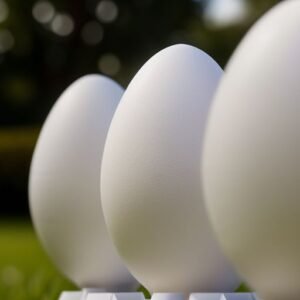
Egg Size
Salmon Faverolle eggs are typically medium to large in size, averaging around 50-60 grams per egg.
Salmon Faverolle Chicken Characteristics
Temperament: Salmon Faverolle chickens are incredibly gentle and friendly, making them perfect for families with kids or anyone new to raising chickens. They are very sociable, getting along well with other chickens and enjoying interaction with humans.
Noise Level: These chickens are pretty quiet, especially compared to other breeds, which makes them a great choice if you live in an urban or suburban area where noise might be an issue.
Lifespan: With the right care, Salmon Faverolle chickens typically live between 5 to 7 years. Some can even live longer if they have a healthy environment and proper management.
Heat Tolerance: They can’t handle warm weather reasonably well, but you’ll need to provide them with plenty of shade and fresh water to keep them cool and comfortable during hot days.
Foraging Abilities: Salmon Faverolle chickens love to forage. They’re active and curious, often roaming around the yard searching for insects and seeds. This natural behavior helps keep them healthy and engaged.
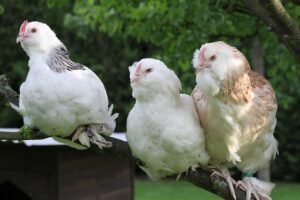
Salmon Faverolle Hen vs Rooster
Appearance:
- Hen: Salmon Faverolle hens have a beautiful mix of light brown and creamy white feathers. They are slightly smaller, weighing around 6.5 pounds. Hens have a more rounded body shape and less pronounced combs and wattles.
- Rooster: Roosters are larger, weighing up to 8 pounds. They display more vibrant and contrasting plumage, with darker feathers around the neck and back. Roosters also have larger combs and wattles.
Behavior:
- Hen: Hens are known for their calm and friendly demeanor. They are very sociable and often enjoy human interaction. Hens are generally less dominant and more likely to get along with other chickens.
- Rooster: Roosters can be more protective and assertive, particularly towards predators. While they can still be friendly, they may exhibit more territorial behavior, especially around other roosters.
Egg Production:
- Hen: Hens are the egg layers, producing about 4-5 eggs per week. Their eggs are medium to large in size and light brown in color.
- Rooster: Roosters do not lay eggs. Their primary role is to protect the flock and, if you plan to breed, to fertilize the eggs.
Noise Level:
- Hen: Hens are relatively quiet, making them suitable for urban or suburban settings.
- Rooster: Roosters tend to be noisier due to their crowing, which can occur throughout the day, especially in the early morning.
Role in the Flock:
- Hen: Hens focus on foraging and egg-laying. They are less likely to exhibit aggressive behavior and often form the core of the flock’s social structure.
- Rooster: Roosters serve as the protectors of the flock, watching for predators and often taking the lead in foraging activities. They can be more assertive but play a crucial role in flock dynamics.
Raising Salmon Faverolle Chicks: Week-by-Week Guide
Week 1:
Keep Salmon Faverolle chicks in a brooder with a temperature of 95°F. Ensure they have access to chick starter feed and clean water at all times. Monitor them closely for any signs of stress or health issues.
Week 2:
Lower the brooder temperature to 90°F. Introduce small perches to encourage roosting behavior, which Salmon Faverolle chicks will enjoy practicing.
Week 3:
Continue lowering the brooder temperature by 5°F each week until the chicks are fully feathered. Provide chick grit to support their digestion, as Salmon Faverolle chicks start exploring different foods.
Weeks 4-5:
Start introducing the chicks to the outdoors for short periods, weather permitting. This helps Salmon Faverolle chicks get used to their new environment gradually and boosts their immune systems.
Here is a complete food plan & nest setup for chicks.
Weeks 6-7:
Transition the chicks to grower feed, which is formulated to meet the nutritional needs of growing Salmon Faverolle chickens. Gradually increase their outdoor time to help them acclimate to outdoor conditions.
Week 8:
Move the chicks to their coop full-time. Ensure the coop is predator-proof and comfortable, providing plenty of space and clean bedding. Salmon Faverolle chicks will now be ready to join the rest of the flock and explore their new home.
Pros & Cons of Salmon Faverolle Chickens
Pros
- Friendly and docile temperament
- Good egg production
- Attractive appearance
- Suitable for families and beginners
- Relatively quiet
Cons
- Moderate heat tolerance may require extra care in hot climates
- Feathered legs can collect dirt and require cleaning
- Not as prolific egg layers as some other breeds
Owner Suitability
Suitable Reasons: Salmon Faverolle chickens are perfect for anyone seeking a friendly, easy-to-manage breed. Their gentle and sociable nature makes them an excellent choice for families with children. Their distinctive appearance, with fluffy beards and muffs, adds a unique charm to any flock, making them a delightful addition for hobbyists and backyard enthusiasts alike.
Unsuitable Reasons: Salmon Faverolle chickens might not be the best choice for extremely hot climates unless you can provide ample shade and cooling methods. Also, if your primary goal is maximum egg production, other breeds, like Leghorns or Rhode Island Reds, might better meet your needs as they tend to lay more eggs consistently.
Salmon Faverolle Chicken Price
The price of Salmon Faverolle chickens can vary based on age, quality, and location. On average, chicks can cost between $5 to $10 each, while mature birds may range from $20 to $50.
Where to Buy Salmon Faverolle Chickens
- Murray McMurray Hatchery: Known for a wide variety of breeds and quality chicks.
- Cackle Hatchery: Offers both chicks and hatching eggs.
- Meyer Hatchery: Provides Salmon Faverolle chicks and detailed care instructions.
- Local Breeders: Check local farm listings or poultry clubs for breeders in your area.
Conclusion
Salmon Faverolle chickens as pets are a delightful breed with a rich history and charming characteristics. They are friendly, relatively quiet, and produce a steady supply of eggs, making them a great addition to any backyard flock. With proper care and attention, these chickens can thrive and bring joy to their owners.
How to Sex Salmon Faverolle Chicks?
Sexing Salmon Faverolle chicks can be challenging, but feather color and growth can provide clues. Males often have darker feathers on their wings, while females tend to be lighter.
What Do Salmon Faverolle Chicks Look Like?
Salmon Faverolle chicks are fluffy with a mix of light and dark down. They have five toes on each foot, a unique trait among many chicken breeds.
Are Salmon Faverolle Chickens Noisy?
Compared to other breeds, Salmon Faverolle chickens are relatively quiet, making them suitable for urban or suburban environments.
How Many Eggs Do Salmon Faverolle Chickens Lay Per Year?
Salmon Faverolle chickens lay approximately 200-240 eggs per year, averaging about 4-5 eggs per week.
Where Can You Buy Salmon Faverolle Chickens for Sale?
You can purchase Salmon Faverolle chickens from reputable hatcheries such as Murray McMurray Hatchery, Cackle Hatchery, and Meyer Hatchery, as well as from local breeders and poultry clubs.
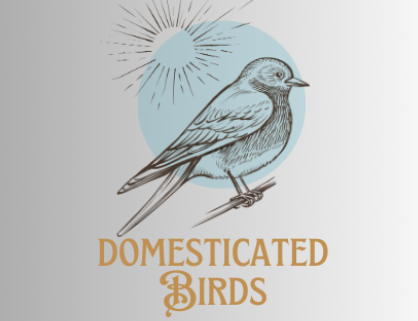
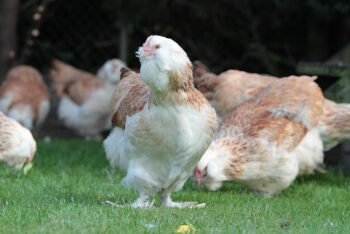
вывод из запоя недорого ростов http://www.vyvod-iz-zapoya-rostov15.ru/ .
вывод. из. запоя. ростов. на. дону. вывод. из. запоя. ростов. на. дону. .
I’ll right away grab your rss feed as I can not find your email subscription link or newsletter service. Do you’ve any? Kindly let me know in order that I could subscribe. Thanks.